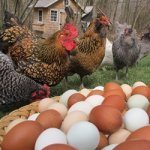Janssen
Admin
I saw this post on a Facebook page and thought it would be good for the eLengo community.

----------
In my early years of keeping chickens, one interesting and annoying habits my chickens had was skipping laying. I expected well-fed hens to lay an egg EVERY DAY!
Most of you seasoned farmers already know why so I wish to share with the newer farmers.
To understand this well, the two main reproductive parts of an egg are Ovary and Oviduct. The yolk (ova) is matured in the ovary then released in the Oviduct where the egg white and shell are formed.
This process, until the egg is laid takes approximately 25-26 hours.
Around 1 hour after the egg is laid, the ovulation process repeats itself for the next egg.
In other words, if a hen lays an egg at 9.00 am today, it will lay the next at 10.00am. This will continue until it will be "too late" at around 3.00pm when ovulation stops until the next day.
It is this periodic break in ovulation that causes the misses in laying and consequently the laying hours. (Chickens rarely lay in the late afternoon and night).
It's also Interesting to learn that light affects the process and clever farmers fix up lights that mimic natural light. This is not only to make them eat more, but also to confuse the hen's system and make her lay continuously.
So there you have it!

----------
In my early years of keeping chickens, one interesting and annoying habits my chickens had was skipping laying. I expected well-fed hens to lay an egg EVERY DAY!
Most of you seasoned farmers already know why so I wish to share with the newer farmers.
To understand this well, the two main reproductive parts of an egg are Ovary and Oviduct. The yolk (ova) is matured in the ovary then released in the Oviduct where the egg white and shell are formed.
This process, until the egg is laid takes approximately 25-26 hours.
Around 1 hour after the egg is laid, the ovulation process repeats itself for the next egg.
In other words, if a hen lays an egg at 9.00 am today, it will lay the next at 10.00am. This will continue until it will be "too late" at around 3.00pm when ovulation stops until the next day.
It is this periodic break in ovulation that causes the misses in laying and consequently the laying hours. (Chickens rarely lay in the late afternoon and night).
It's also Interesting to learn that light affects the process and clever farmers fix up lights that mimic natural light. This is not only to make them eat more, but also to confuse the hen's system and make her lay continuously.
So there you have it!
